Chapter Index
This trip will have taken place more than eight years ago by the time you read this. Given the likely time horizon that this post will be archived and saved on the internet, the probability is significant that you’ll be reading this several years, if not decades, maybe even a century beyond that. Certainly this journal entry will look very different being authored eight years after the fact than if I had been prompt and reported on my experience immediately in 2011. Memory becomes fuzzier, but with more distance there’s also more perspective. Events and observations that once seemed hugely important have diminished with time and might be either accidentally or deliberately left out entirely. I’m not sure whether that’s good or bad. Hopefully with age and experience it’s also less pretentious than my writing from eight years ago… but no promises.
I was in Hong Kong for four months in my senior year as part of my university’s Study Abroad program, hosted at the Hong Kong University of Science & Technology. This included side trips to mainland China, Malaysia, Singapore, Taiwan, and a fifth month of travel through Korea and Japan. Four years earlier in 2007 I didn’t have a good plan for college applications as I finished high school, and ended up making a last-minute decision to accept at my in-state safety school option. The silver lining of this was that I had more money and initiative to take advantage of the Study Abroad program to get out of state as much as possible. First I went to Rome, followed by London in 2010, and for my third program in spring of 2011 I ended up across the Pacific in Hong Kong. I tried to go for a fourth program in my super-senior year, possibly in South America, but was told there were no programs left that could satisfy my remaining credit requirements. So Hong Kong would be my final opportunity to live in another part of the world for an extended time as a student, where everything is (somewhat solipsistically) about your own personal learning and growth.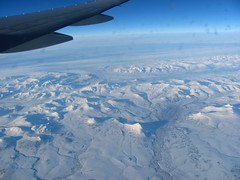
The flight there had a sense of excitement. I was furiously writing for much the plane trip, trying to wrap up my epic report series from Europe as quickly as possible, occasionally glimpsing out the window at the frozen mountains on the Kamchatka peninsula. I had a mission. Returning home was a different matter. For several years, being a world traveler planning my next adventure became central to my sense of self and purpose. Once I landed home, there was no next adventure. I lost that purpose. All that was left was to memorialize those experiences on this website, a process that felt a little bit like death. It’s no wonder that this journal kept getting put off for more than eight years.
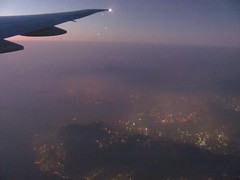
Yet I never considered abandoning this project entirely because I knew that sooner or later I would have to leave some form of testimony to my experience. Is that the meaning of life? The question is a cliché, yet in 2011 I heard an unsuspecting answer that stayed with me. We must bear witness to the world, and then are compelled to leave some form–any form–of testimony to what we saw. It’s an answer that on its face is so simple, so trivial, and yet so subtly powerful. What is all of social media but a primal expression of this existential desire? By the end of the trip, I could testify: I took 12,023 photos and videos. Each one was my own little testimony to a moment in time and space, something in the world that captured my attention for long enough that I thought it deserved some limited form of immortality.
There was a lot to immortalize.
The first picture I took in Asia was riding the late night bus with my cousin Caroline, who was also participating in the same program at HKUST from a different university in Michigan. The blurriness captured the feeling.
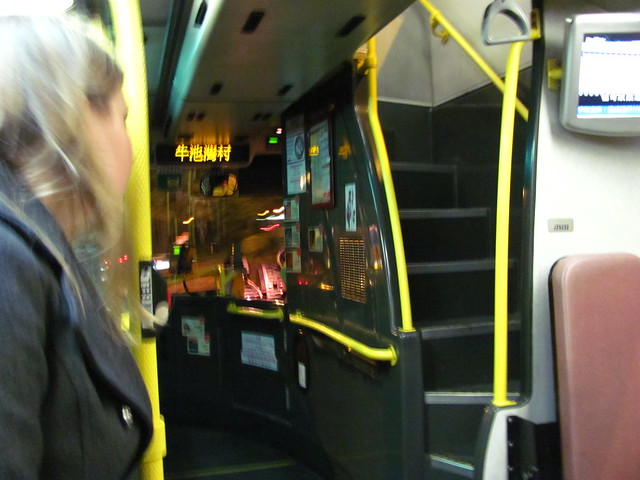 I fell asleep almost immediately when I arrived in the empty dorm, then woke up in the middle of the night to watch Watchmen, then slept again. The next morning I awoke and opened the door of room 321 to this view:
I fell asleep almost immediately when I arrived in the empty dorm, then woke up in the middle of the night to watch Watchmen, then slept again. The next morning I awoke and opened the door of room 321 to this view:
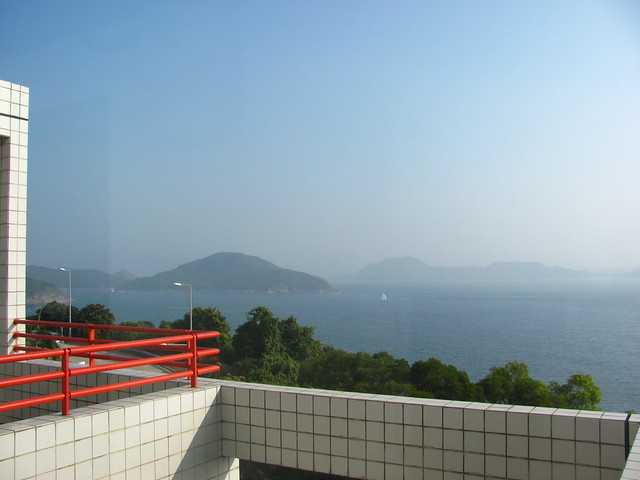
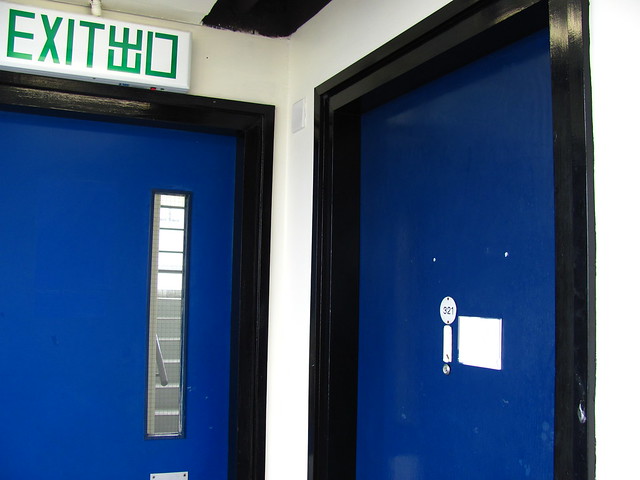 Undergraduate Hall III is located on the shores of Clear Water Bay on the eastern side of Hong Kong. The University is perched on a steep hillside overlooking the bay, with most of the dormitories located on the lowest level. The views at time were practically unreal; the photo below was taken a few days later as I was walking from my dorm complex on my way to class, and remembered that my camera was in my backpack.
Undergraduate Hall III is located on the shores of Clear Water Bay on the eastern side of Hong Kong. The University is perched on a steep hillside overlooking the bay, with most of the dormitories located on the lowest level. The views at time were practically unreal; the photo below was taken a few days later as I was walking from my dorm complex on my way to class, and remembered that my camera was in my backpack.
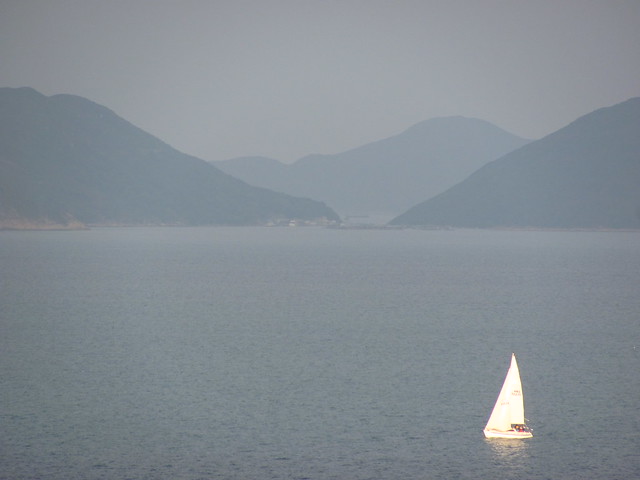 To get to the classroom and cafeteria areas, I had to take a series of elevators and bridges up to three different terraces. The total height differential was probably equivalent to one of the skyscrapers downtown. Despite being somewhat utilitarian in design with the same square white tiles everywhere, it really is an incredible campus that at times feels more like a resort than a university. It’s a long way up…
To get to the classroom and cafeteria areas, I had to take a series of elevators and bridges up to three different terraces. The total height differential was probably equivalent to one of the skyscrapers downtown. Despite being somewhat utilitarian in design with the same square white tiles everywhere, it really is an incredible campus that at times feels more like a resort than a university. It’s a long way up…
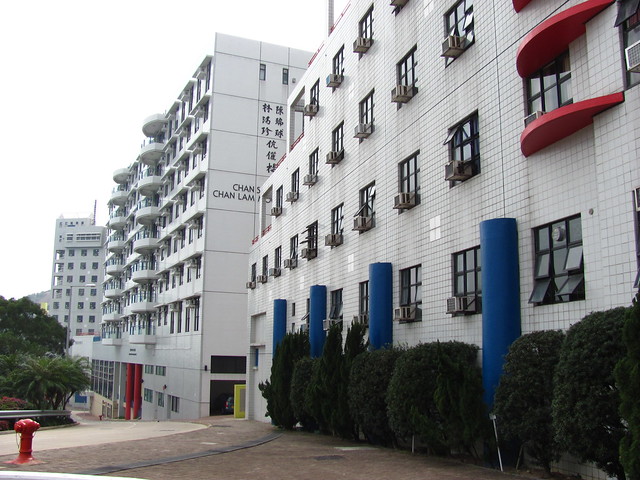
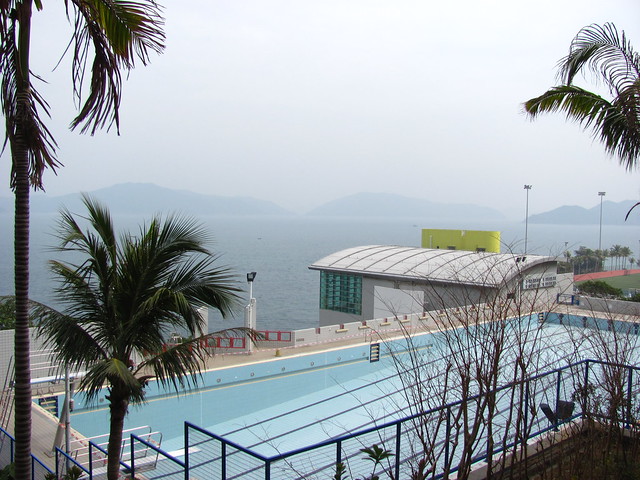
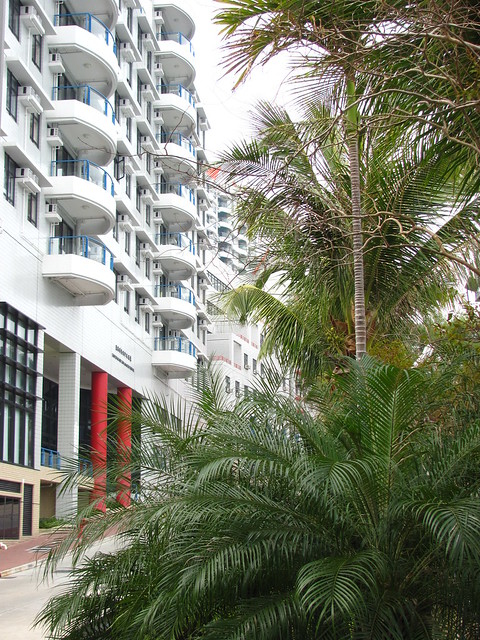
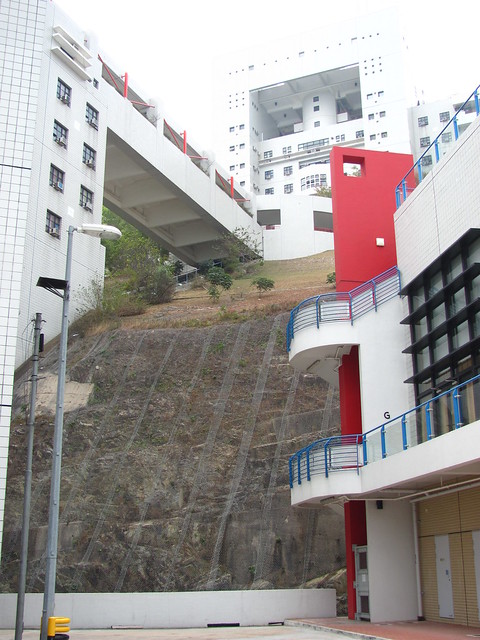
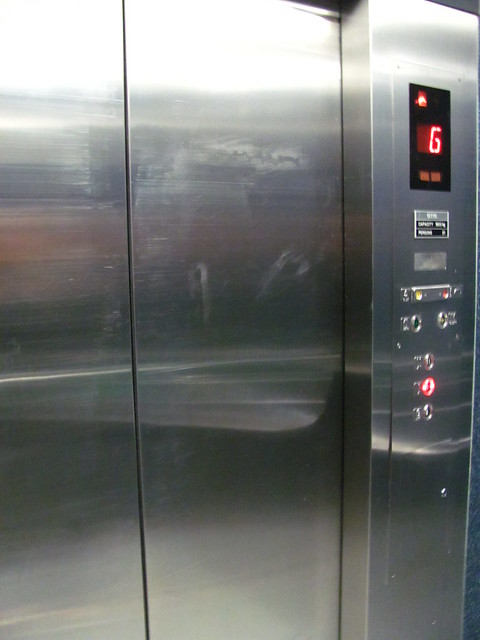
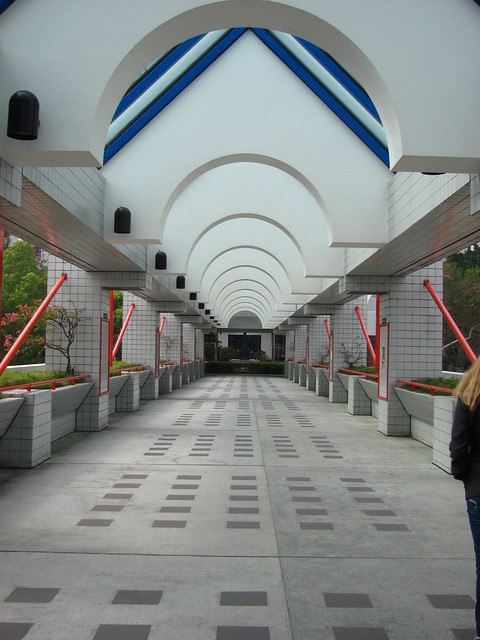
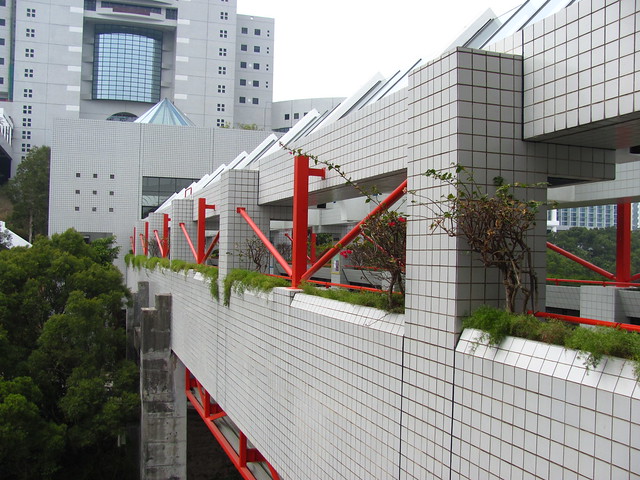
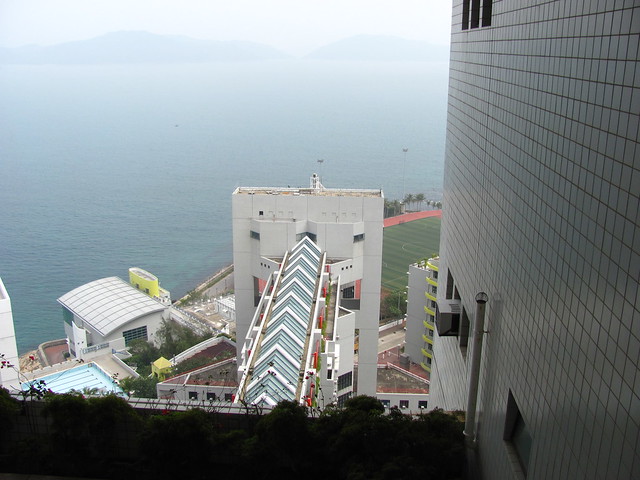
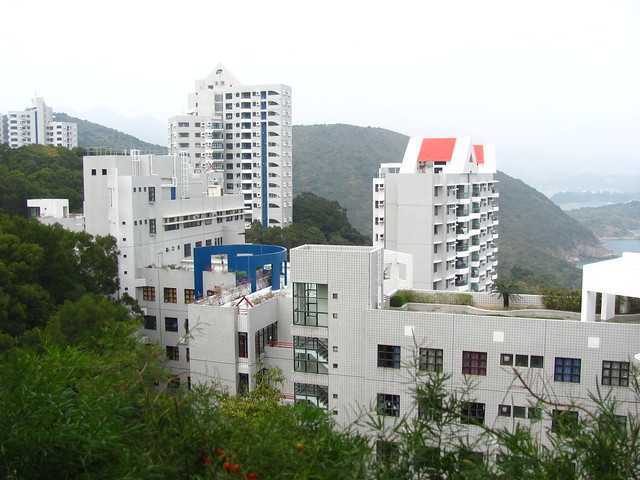
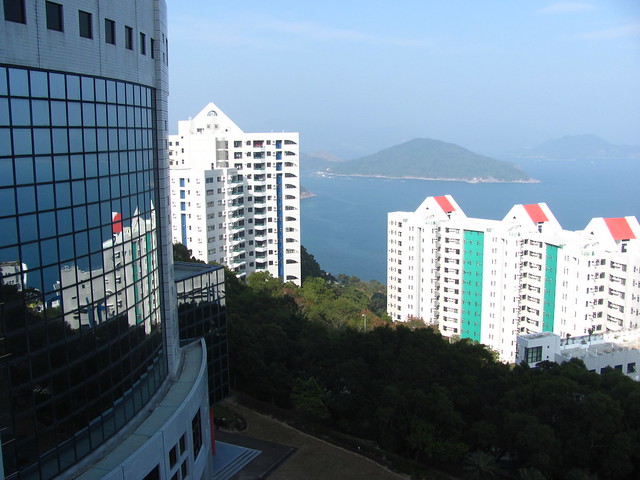
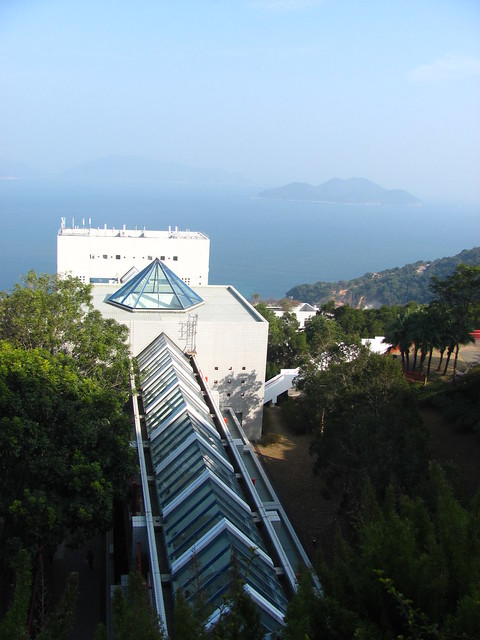
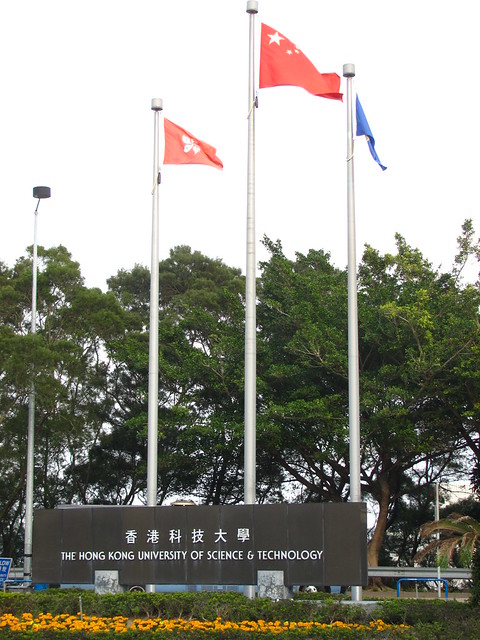

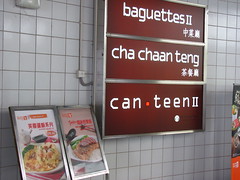 Food options on campus were… not great. There were several cafeterias at different levels, which mostly served Cantonese or Southeast Asian dishes. One of my first, a chopped chicken dish had so much salt and bone fragments in it I couldn’t finish. Fortunately it wasn’t just my American palate; local students confirmed to me that the food was awful by Chinese standards as well. There were a few noodle dishes that were adequate, and these quickly became go-to meals when the adventure of trying new dishes had worn off. An “Italian-style” pasta dish was also offered at the cafeteria, although the cooking methods and taste profile clearly was unable to make the transition across continents. Yet there was still a McDonald’s on campus as the only option for American food; I ate more Big Macs over the course of a semester
Food options on campus were… not great. There were several cafeterias at different levels, which mostly served Cantonese or Southeast Asian dishes. One of my first, a chopped chicken dish had so much salt and bone fragments in it I couldn’t finish. Fortunately it wasn’t just my American palate; local students confirmed to me that the food was awful by Chinese standards as well. There were a few noodle dishes that were adequate, and these quickly became go-to meals when the adventure of trying new dishes had worn off. An “Italian-style” pasta dish was also offered at the cafeteria, although the cooking methods and taste profile clearly was unable to make the transition across continents. Yet there was still a McDonald’s on campus as the only option for American food; I ate more Big Macs over the course of a semester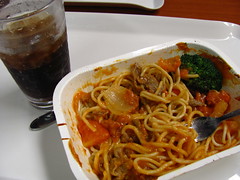 than I’d ever care to count.
than I’d ever care to count.
Most classes were conducted in English, with a few offered in either Cantonese or Mandarin. I ended up having to make some rearrangements to my schedule after discovering a couple of my selected classes that the course guide promised as “English language” classes were really anything but. One was a class about 20th century Chinese history that sounded intriguing in the description. When I arrived on the first day, there were all of two other students; one Chinese and one other white American dude. The professor walked in and, noticing the Americans in the room, quickly informed us in perfectly spoken English that this class would in fact be taught in Mandarin. She then launched into an impressive Mandarin monologue for her audience of now-one, while the two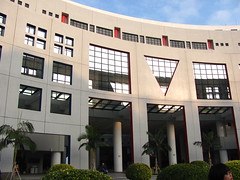 of us spent the period exchanging awkward glances and checking the course guide for substitute classes.
of us spent the period exchanging awkward glances and checking the course guide for substitute classes.
Another was a Philosophy of Language class that sounded right up my alley, although I had suspicions as to whether it was truly English-speaker friendly since it compared the foundations of English and Chinese. Sure enough, I discovered that although the class was offered in English, a working understanding of written Chinese was still required. The first lesson provided an illustrating contrast between the two languages: we read a chunk of text written in both English and Chinese with all spaces and punctuation removed. Whiletheenglishwasdifficulttoreadbutnotimpossiblethechinesetextelictedgaspsofdisbelieffromthechinesestudentsoverhowthetextwasrenderedcompletelyillegible.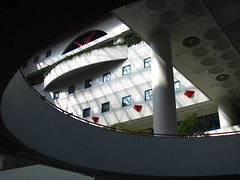 It seemed like a fascinating class, and surprisingly the professor suggested afterward that I might still be able to take it if I was willing to learn the 100 or so Chinese characters before each class, but it seemed clear I’d be at a permanent disadvantage and elected to take another subject.
It seemed like a fascinating class, and surprisingly the professor suggested afterward that I might still be able to take it if I was willing to learn the 100 or so Chinese characters before each class, but it seemed clear I’d be at a permanent disadvantage and elected to take another subject.
A Chinese film history class substituted for one of my liberal arts electives, which was fun although also a total cakewalk, seeing as I was also a former film studies major moonlighting among a school of engineers and business students. A couple of business courses formed the core of my curriculum, as I had a dual major between philosophy and business. One, an accounting class, held lectures at 8:00am on Mondays, my only class scheduled that day of the week.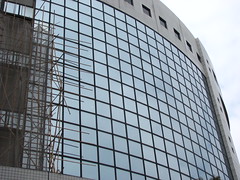 Sitting in a darkened amphitheater that early in the morning listening to the professor drone on… it took two weeks of gouging my hand with the end of my pen in an attempt to stay alert before succumbing to sleep for the rest of the hour when I determined that lecture attendance was optional. Except for the weeks before the midterm and final when I crammed furiously with my textbook, I barely even thought about accounting for the entire semester, instead using my three-day weekends as an opportunity to do more travel. I deservedly got a C, which was still passing. I have absolutely no regrets.
Sitting in a darkened amphitheater that early in the morning listening to the professor drone on… it took two weeks of gouging my hand with the end of my pen in an attempt to stay alert before succumbing to sleep for the rest of the hour when I determined that lecture attendance was optional. Except for the weeks before the midterm and final when I crammed furiously with my textbook, I barely even thought about accounting for the entire semester, instead using my three-day weekends as an opportunity to do more travel. I deservedly got a C, which was still passing. I have absolutely no regrets.
I lost my faith in the future of humanity during a business ethics class. We were presented with a real life scenario: a major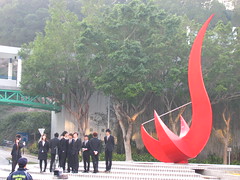 company underwent a scandal when it was discovered their labor sources included child sweatshop labor. But the children’s families needed the money or else they might be bound for destitution. What should the company do to handle this crisis? Here’s what the correct (real life) answer was: they offered a massive payout to the children’s families and provided the kids free education through college. What did virtually every classmate (and future business leader) in that room insist was the correct course of action? It would be an incredible act of mercy to let the kiddos keep working for their paychecks despite the all the bad press they bring to our company!
company underwent a scandal when it was discovered their labor sources included child sweatshop labor. But the children’s families needed the money or else they might be bound for destitution. What should the company do to handle this crisis? Here’s what the correct (real life) answer was: they offered a massive payout to the children’s families and provided the kids free education through college. What did virtually every classmate (and future business leader) in that room insist was the correct course of action? It would be an incredible act of mercy to let the kiddos keep working for their paychecks despite the all the bad press they bring to our company!
Yet the one class that ended up defining my experience at HKUST was the one that I didn’t even need to take as an elective (except for to maintain a minimum number of credits to maintain my status as a full-time student): Intro to Japanese. Foreign languages never came easy to me, but after stumbling through Italian 101 while I was in Rome the previous year, only just becoming conversant enough as the semester was ending and I was preparing to leave, I decided that learning and using a foreign language could be a good life experience if I planned it in such a way that I could actually use my skills. I knew my trip would culminate with a tour of Japan after the semester was over, so Japanese it was.
Here’s the thing: even though the instructional portions of the class were conducted in English, when you’re taking an Asian-language class with 90% native Mandarin and Cantonese speakers (and at a competitive university in the nation that coined the idea of “tiger parenting”), you’re probably going to be starting at a disadvantage. The amount of time I spent reviewing flashcards of hiragana and katakana scripts, memorizing vocabulary words, and reviewing grammar instructions outside of class easily exceeded the amount of time spent on all my other subjects that semester combined. While the Chinese students could use Japanese kanji characters on their written tests and assignments (which have the same meaning and nearly identical strokes as their native Chinese characters), the professor considered it a gracious exception that I wouldn’t be docked points for memorizing the vocabulary and spelling of these words with the phonetic hiragana script instead.
But I was determined not to fail. With a lot of study and hard work, I was eventually able to write (from memory in a test environment, but having been earlier given the prompt and allowed to practice sample drafts) an entire 1-page essay in Japanese script, perhaps my proudest accomplishment that semester… until I got back a C- on that assignment. With that being my “high-point” in that class, failure became inevitable (especially once I realized in the final weeks that, as an elective elective, it wouldn’t affect my stateside GPA). The only class of my entire academy career I would ever fail, ultimately the lesson was that the life experience was more important than the letter handed out at the end. In that regard, I did achieve my goal with that class by learning enough Japanese that I was able to use it in some practical situations when I ultimately traveled Japan.
Flashback to the day after our first arrival more than a week before Lunar New Year and classes would begin. It was plenty of time to discover Hong Kong. My cousin Caroline and I, along with a new group of acquaintances, decided to venture into the city for the first of what would be many times. This required first a brief bus ride, followed by a short walk through a residential area (note, residential areas in Hong Kong are still extremely vertical), and finally onto the MTR, Hong Kong’s massive subway system.
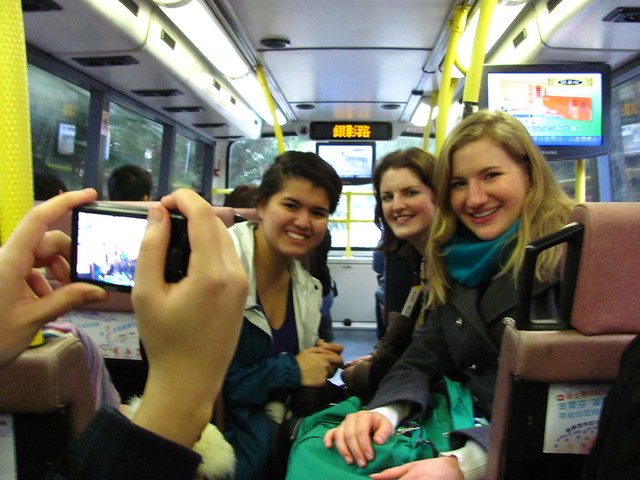
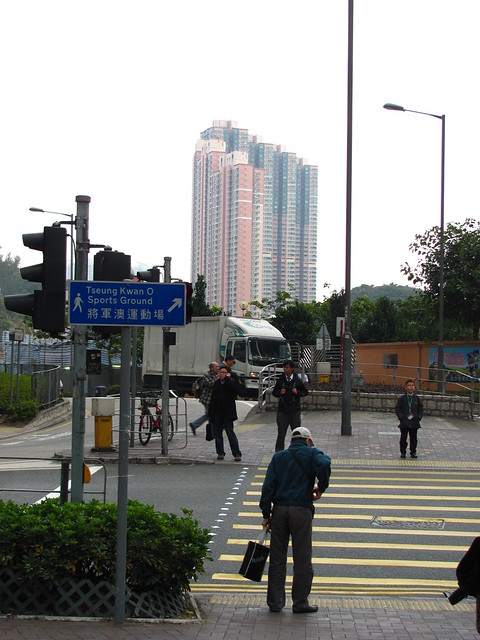
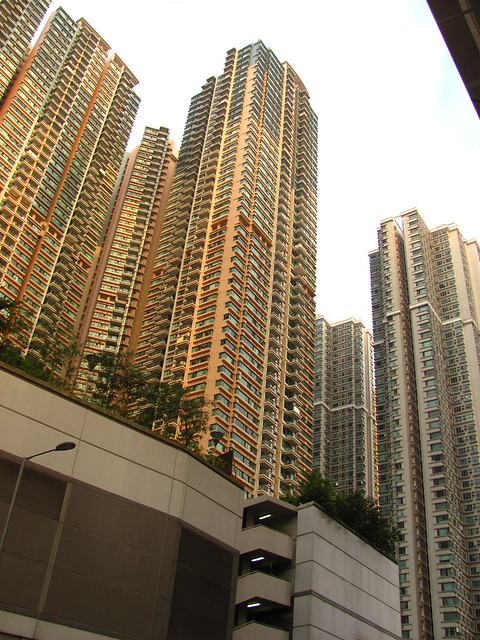
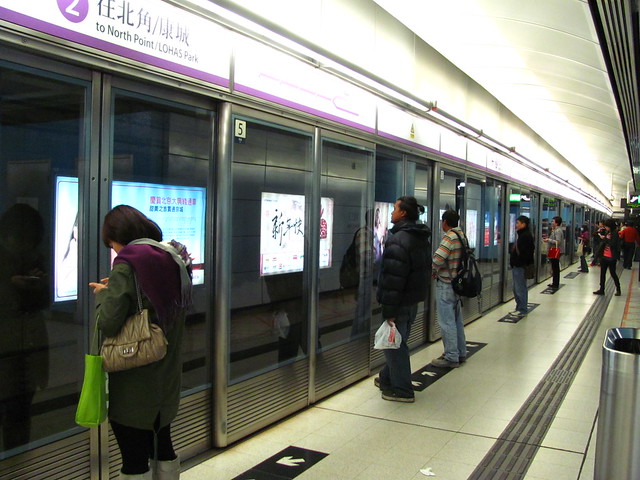 We then got our first glimpse of the city lights on Hong Kong Island, where the biggest skyscrapers are found:
We then got our first glimpse of the city lights on Hong Kong Island, where the biggest skyscrapers are found:
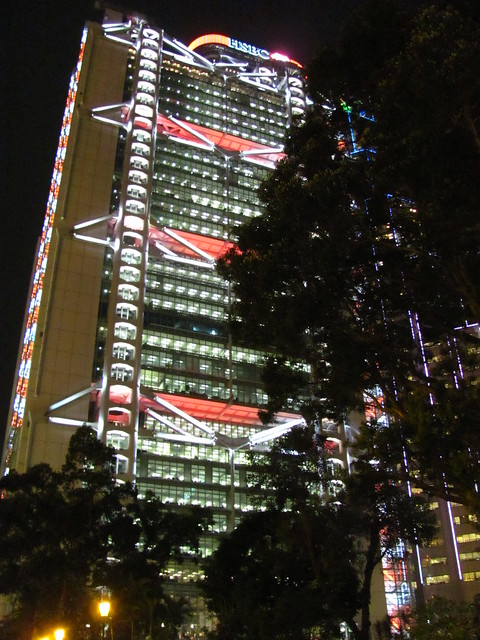
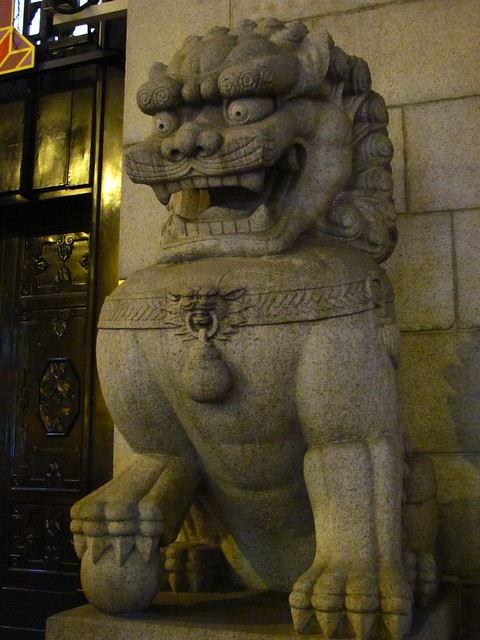
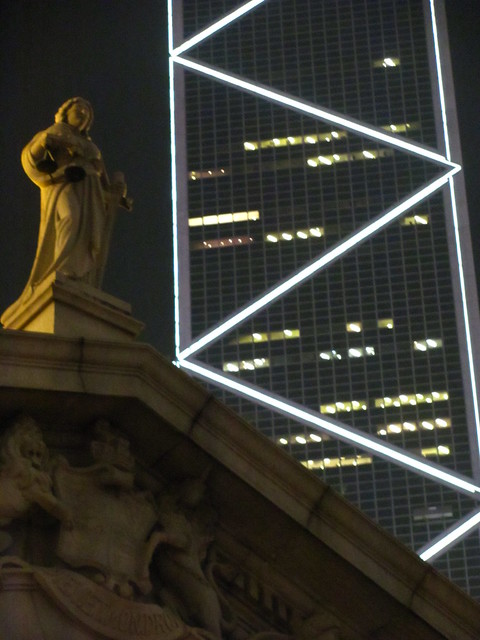
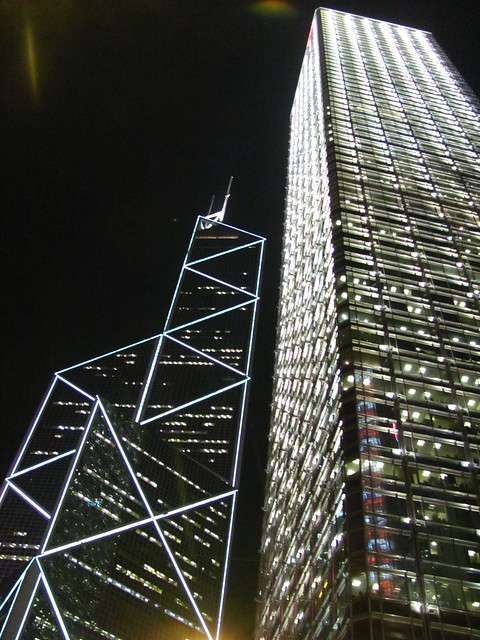
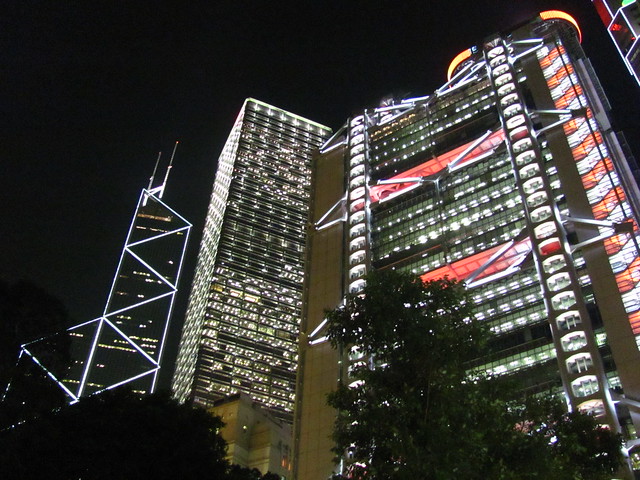 While this area known as Central has the most impressive architecture, it’s not a particularly active area after dark. For that, we would have to take the MTR back under Victoria Harbour to Mong Kok in Kowloon, the peninsular tip of Hong Kong attached to the mainland. After a quick dinner at a modern Cantonese restaurant, we explored the hectic shopping area known as the Ladies’ Market along Tung Choi Street. (Despite what the Virginia Hourly Hotel might suggest, this is a street marketplace for ladies, not of ladies. Mong Kok is full of street markets named for a particular good, even if they’re much more diverse than the name would suggest, such as the Flower Market, Goldfish Market, Sneaker Market, etc.)
While this area known as Central has the most impressive architecture, it’s not a particularly active area after dark. For that, we would have to take the MTR back under Victoria Harbour to Mong Kok in Kowloon, the peninsular tip of Hong Kong attached to the mainland. After a quick dinner at a modern Cantonese restaurant, we explored the hectic shopping area known as the Ladies’ Market along Tung Choi Street. (Despite what the Virginia Hourly Hotel might suggest, this is a street marketplace for ladies, not of ladies. Mong Kok is full of street markets named for a particular good, even if they’re much more diverse than the name would suggest, such as the Flower Market, Goldfish Market, Sneaker Market, etc.)
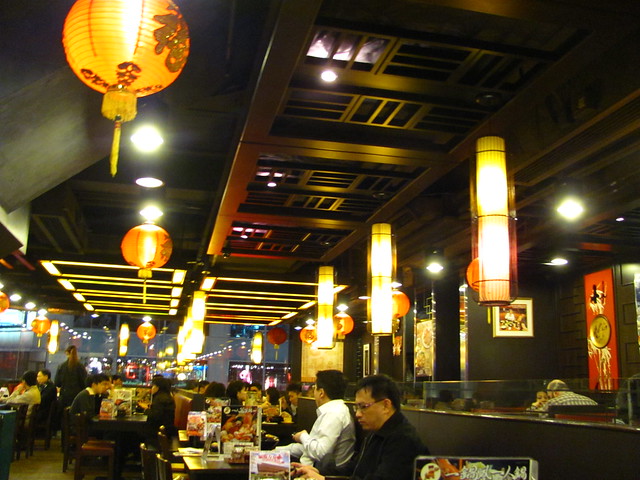
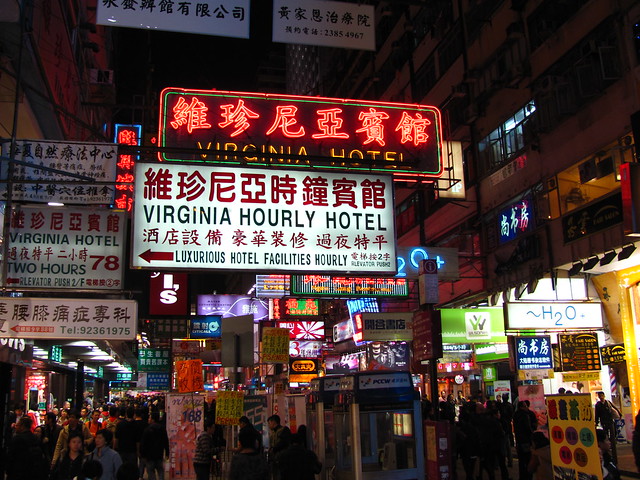
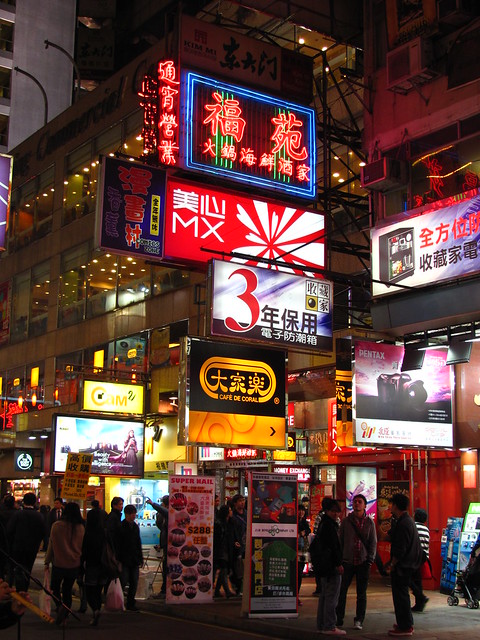
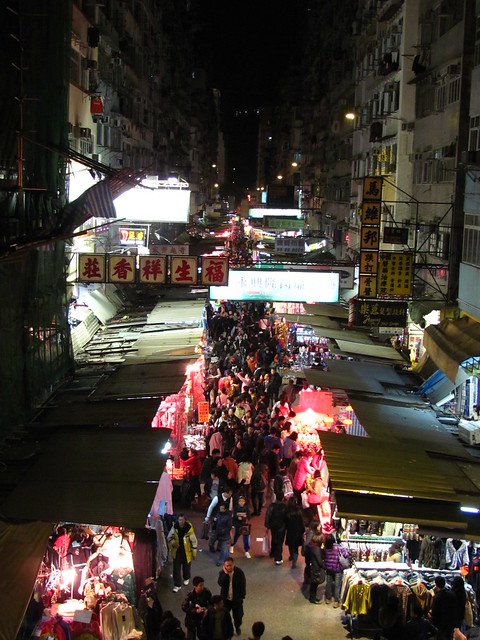
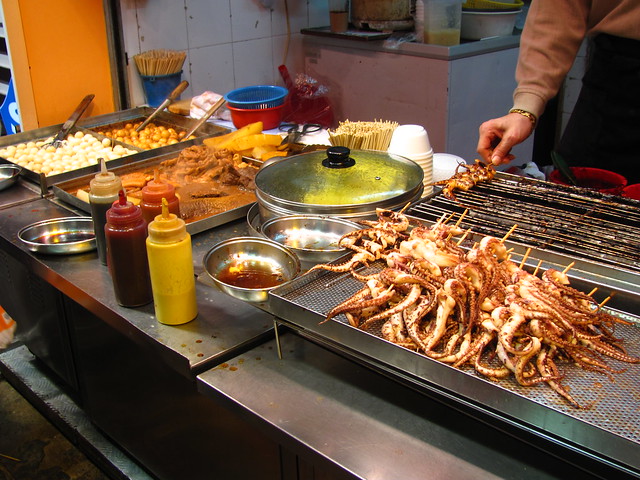 Finally, along Avenue of Stars (named as the Hong Kong film industry’s version of the Hollywood Walk of Fame), there’s a magnificent view across Victoria Harbour back towards the skyline on Hong Kong Island, complete with a nighttime light show! (Essentially some of the skyscrapers gently blink or change color while faint music plays in the background. The view is just as good without the show.)
Finally, along Avenue of Stars (named as the Hong Kong film industry’s version of the Hollywood Walk of Fame), there’s a magnificent view across Victoria Harbour back towards the skyline on Hong Kong Island, complete with a nighttime light show! (Essentially some of the skyscrapers gently blink or change color while faint music plays in the background. The view is just as good without the show.)
The following afternoon, free of any remaining university functions, I went out with new friends Igor and Mariel to explore more of Mong Kok’s street markets, starting with the bird market (should you want an exotic pet).
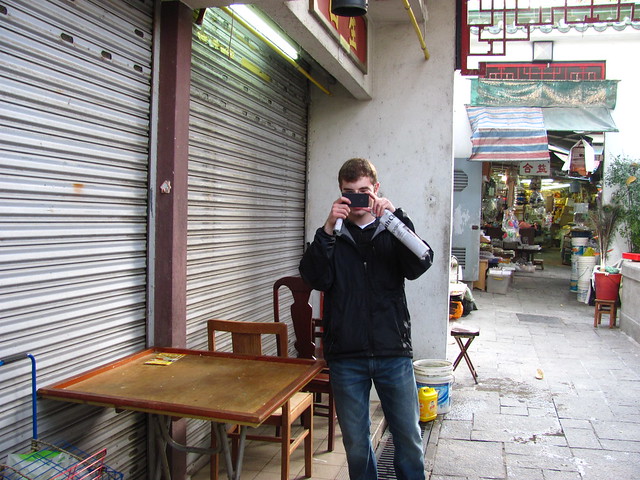
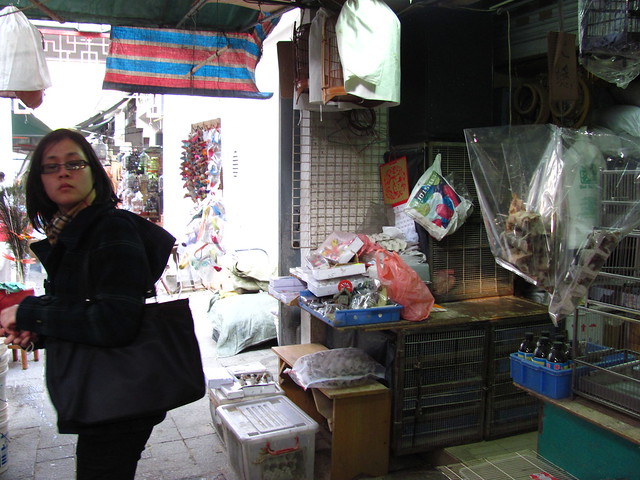
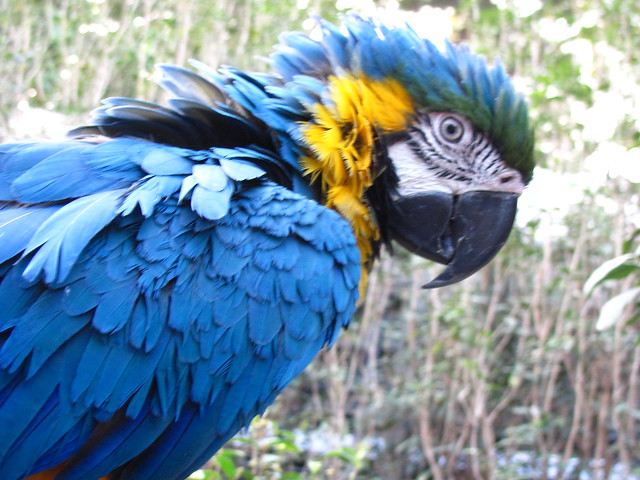
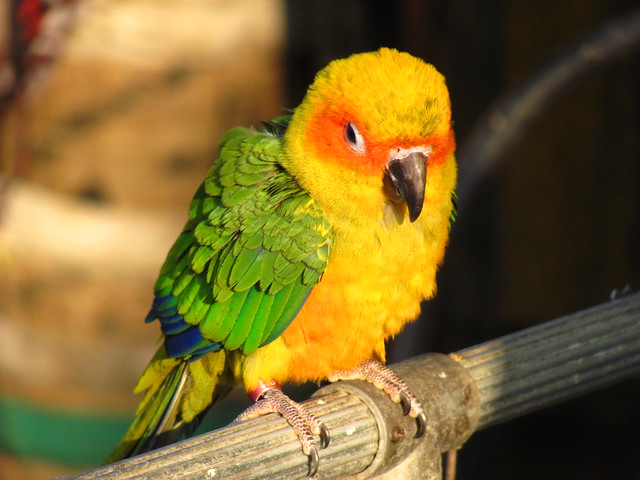
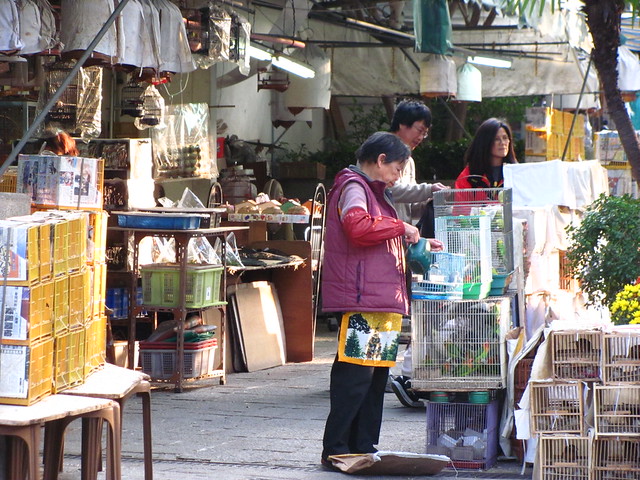 After a short stroll, we next arrived at the outdoor flower market. This area was abuzz with activity, as the Lunar New Year was just days away and everyone was out buying flower arrangements, orchids, and even citrus plants. (Oranges are important for New Year as they’re said to bring luck and prosperity. The Chinese words for each sound similar, hence the association. This is a common motif in Chinese culture.)
After a short stroll, we next arrived at the outdoor flower market. This area was abuzz with activity, as the Lunar New Year was just days away and everyone was out buying flower arrangements, orchids, and even citrus plants. (Oranges are important for New Year as they’re said to bring luck and prosperity. The Chinese words for each sound similar, hence the association. This is a common motif in Chinese culture.)
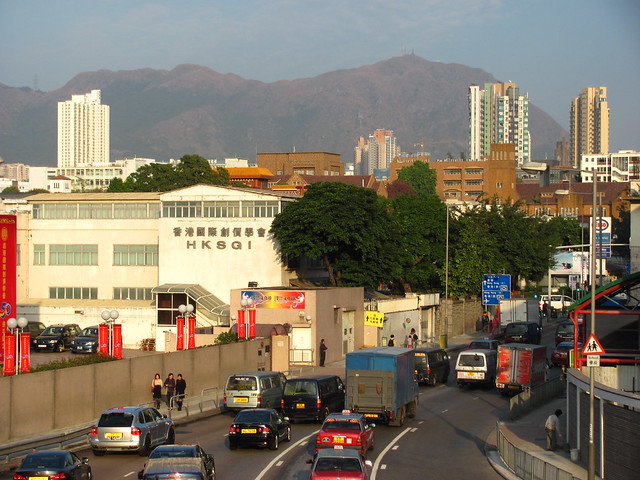
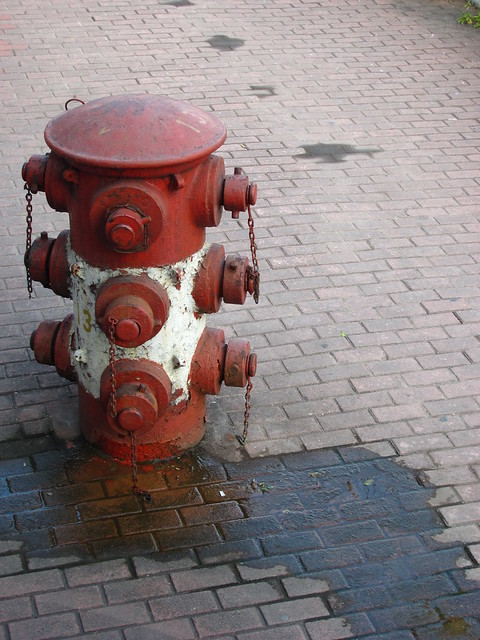
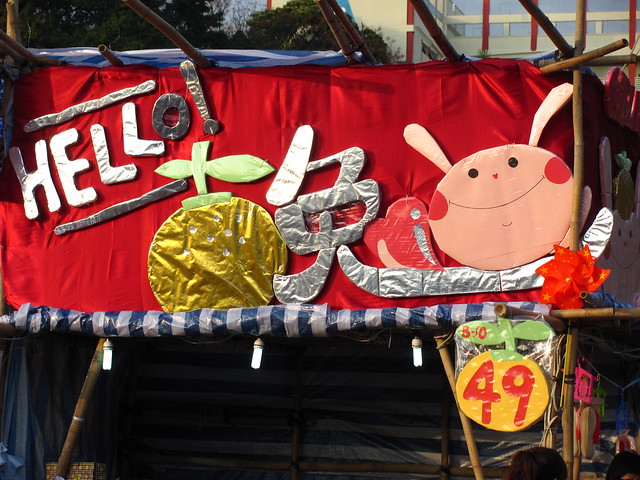
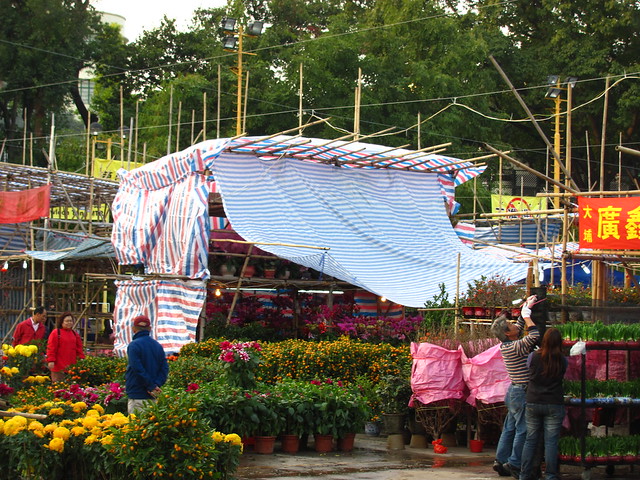
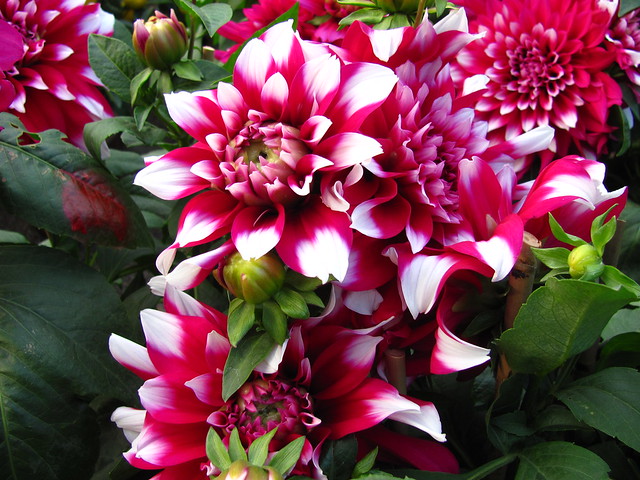
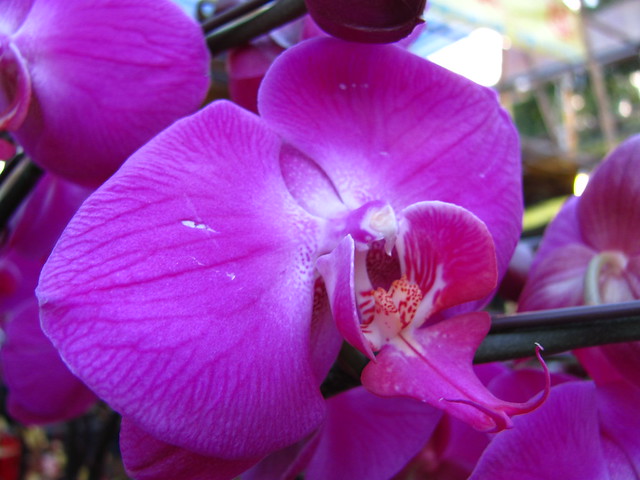
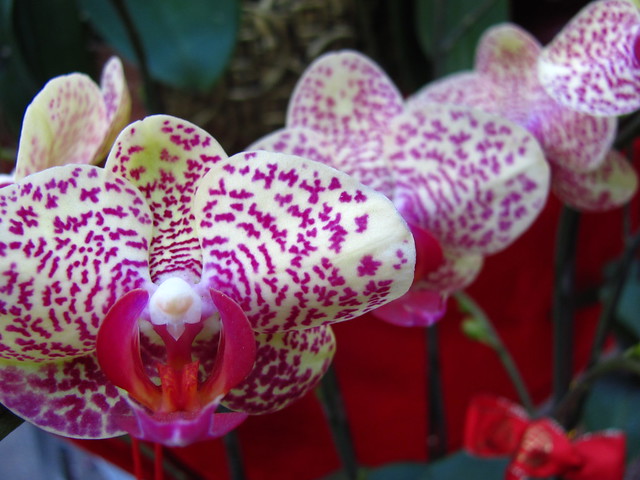
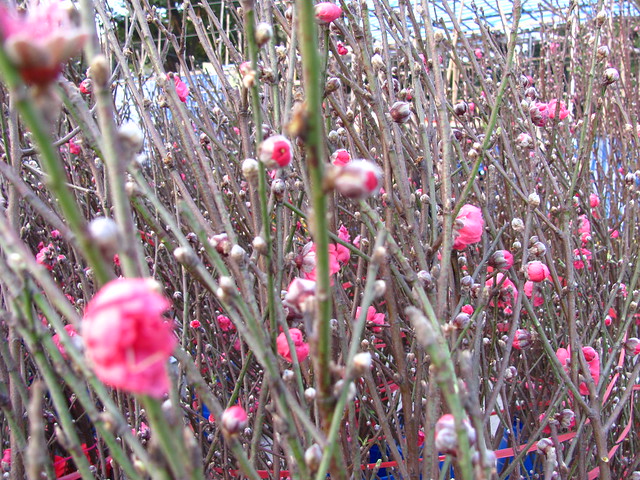
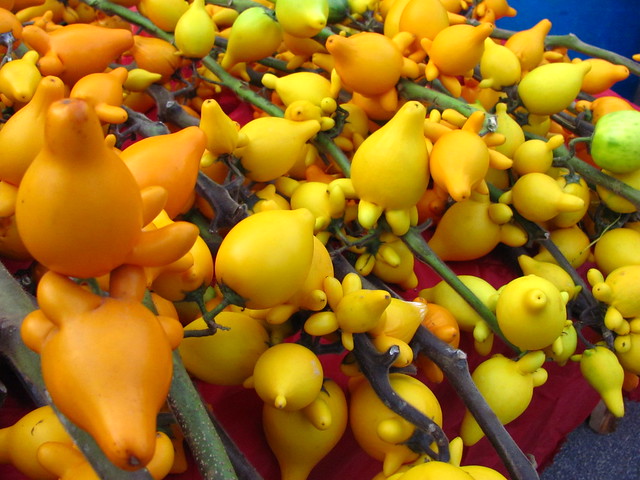
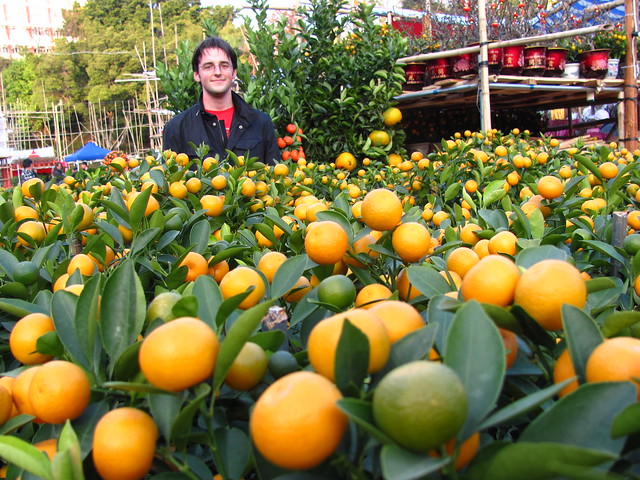
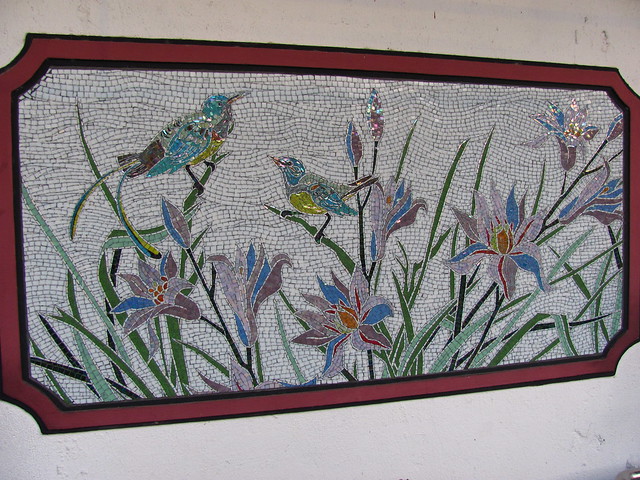 Lastly, the fish market was not particularly good for tourists. This was primarily due the extremely poor living conditions many of the pets (or meals?) are subjected to falling short of international standards.
Lastly, the fish market was not particularly good for tourists. This was primarily due the extremely poor living conditions many of the pets (or meals?) are subjected to falling short of international standards.
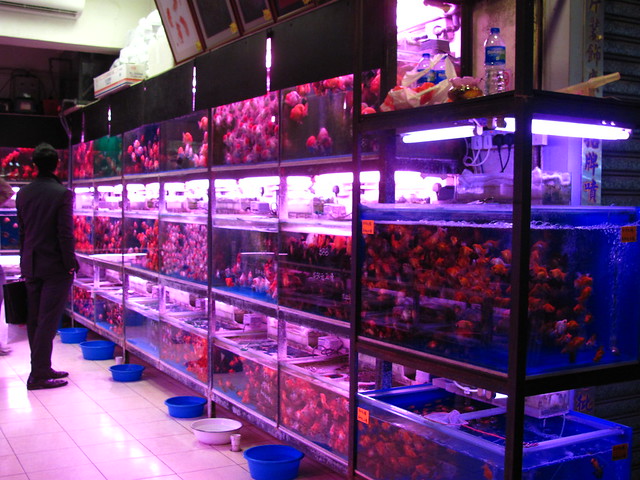
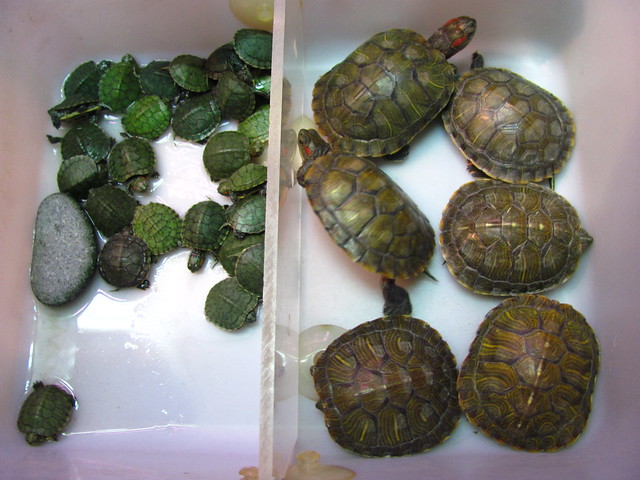
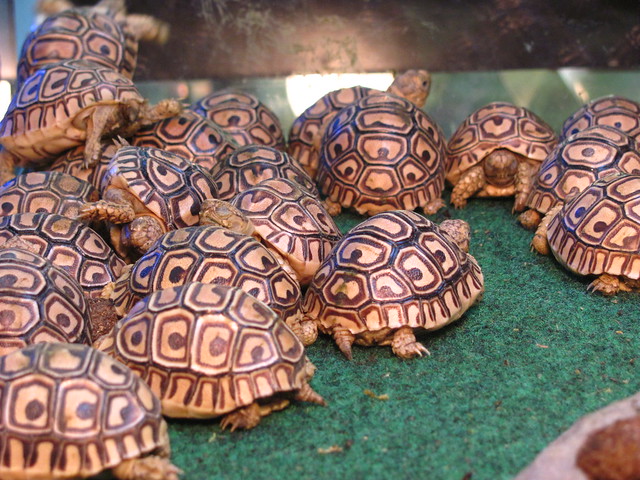
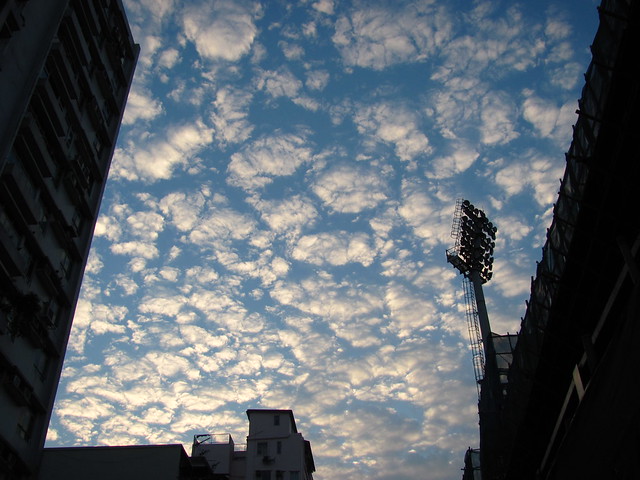
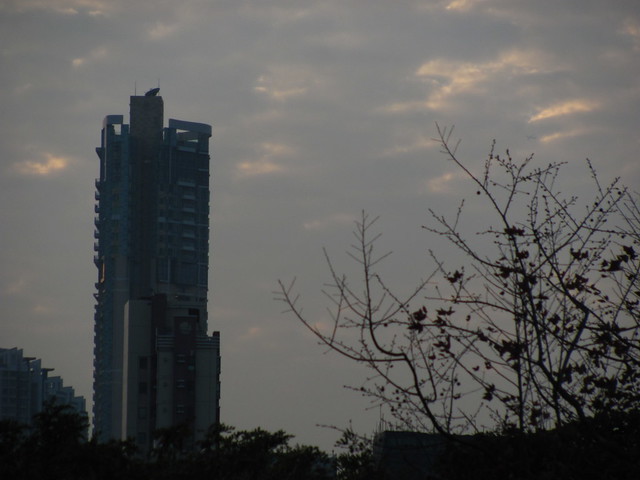 As the days quickly counted down to Lunar New Year, there were more festivities around Hong Kong to experience. One that I was very much looking forward to was the New Year Parade. To be honest this was a bit of a disappointment, if only because I was expecting something equivalent to some big budget American parade spectaculars, when in fact it was more about representing various community groups (many international), with the few big floats all roving corporate billboards, and some very long dead spots in between. (America has plenty of those types of parades too.) A few fun moments, but not quite worth the three-plus hours of standing along the street to witness. Nevertheless, we got there early enough for a prime viewing spot, and we were going to make the most of it!
As the days quickly counted down to Lunar New Year, there were more festivities around Hong Kong to experience. One that I was very much looking forward to was the New Year Parade. To be honest this was a bit of a disappointment, if only because I was expecting something equivalent to some big budget American parade spectaculars, when in fact it was more about representing various community groups (many international), with the few big floats all roving corporate billboards, and some very long dead spots in between. (America has plenty of those types of parades too.) A few fun moments, but not quite worth the three-plus hours of standing along the street to witness. Nevertheless, we got there early enough for a prime viewing spot, and we were going to make the most of it!
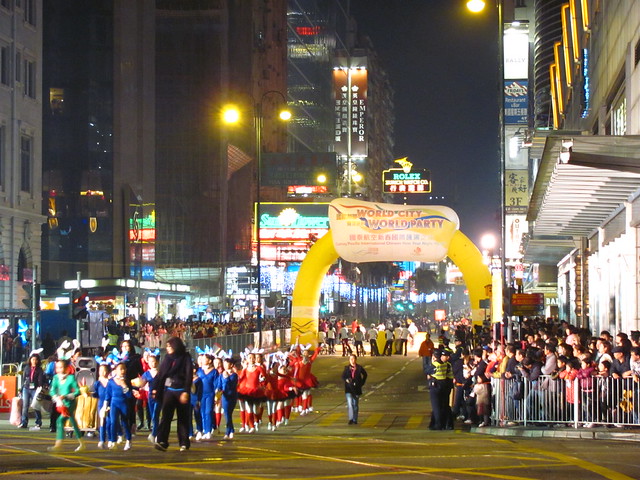
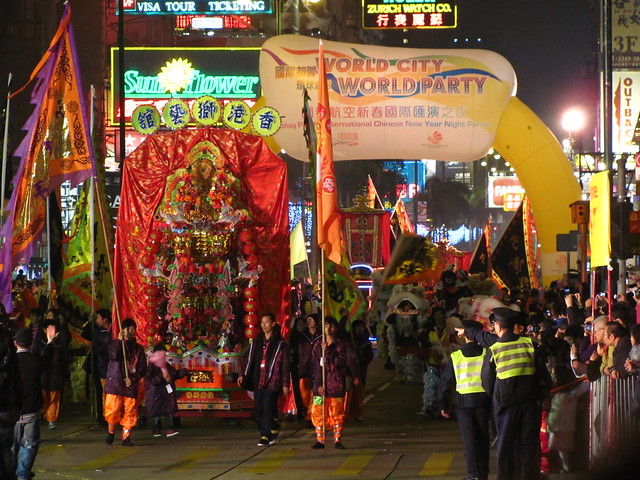
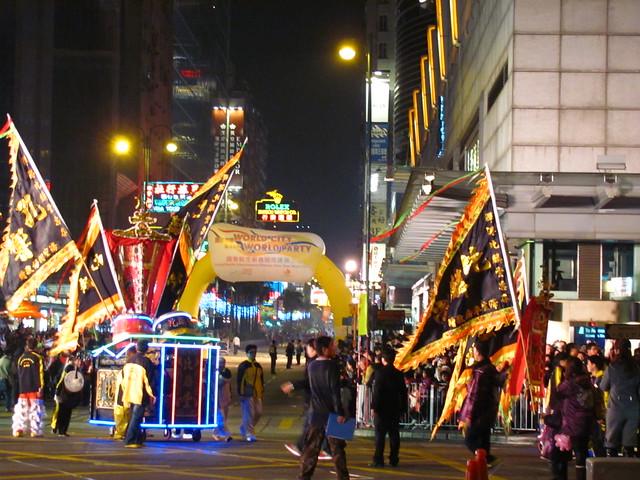
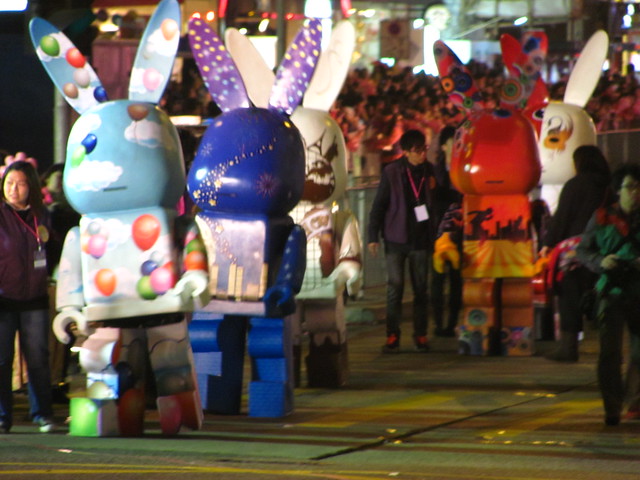
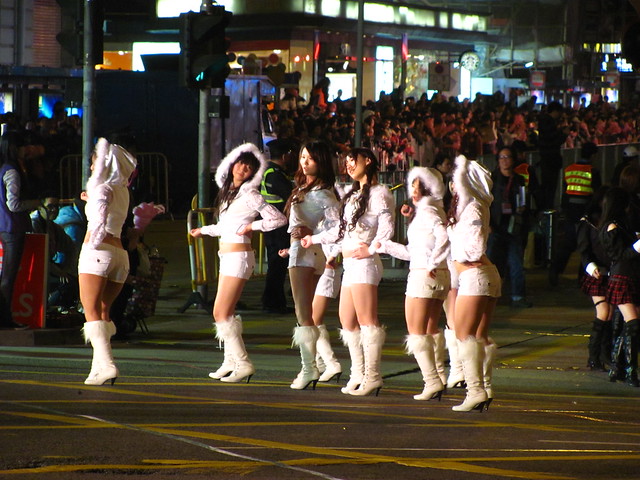
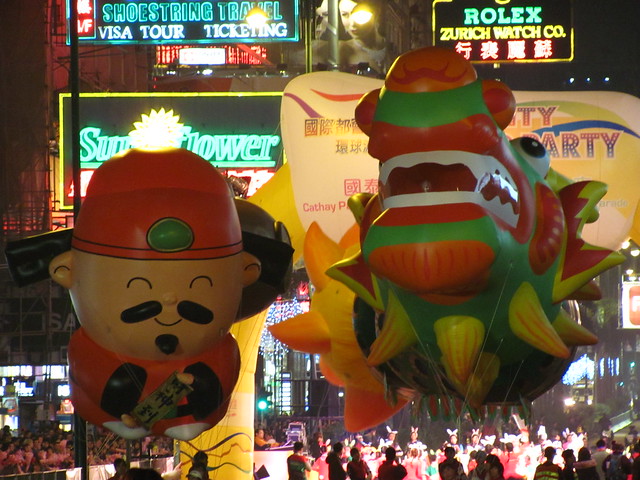
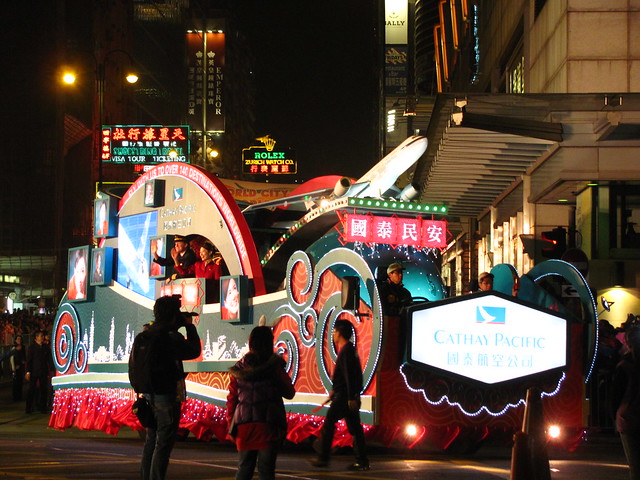
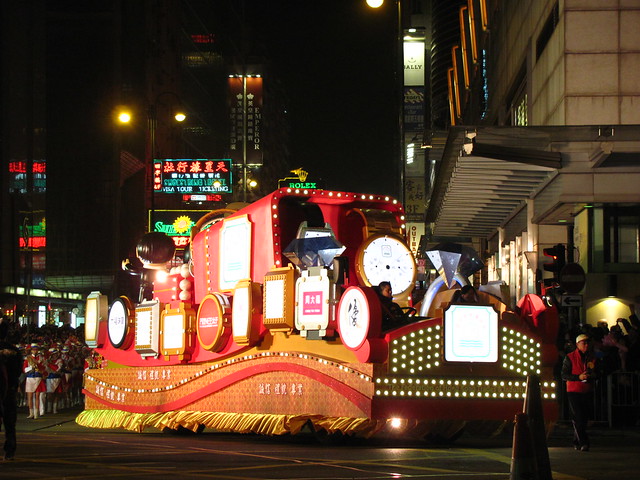
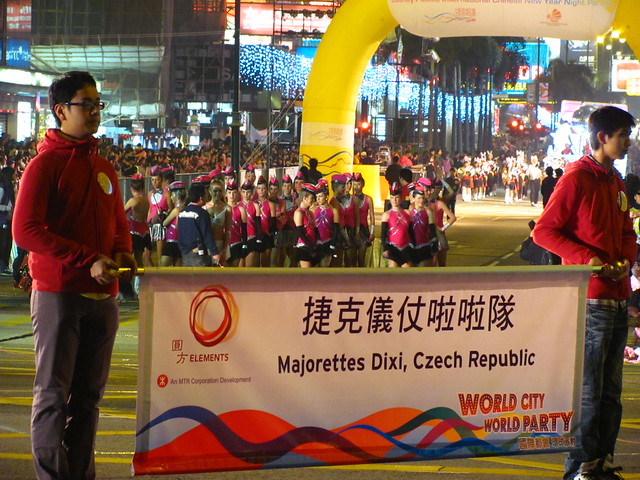
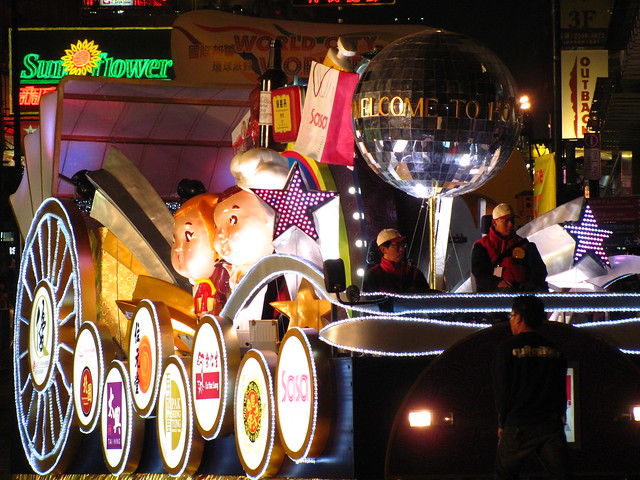
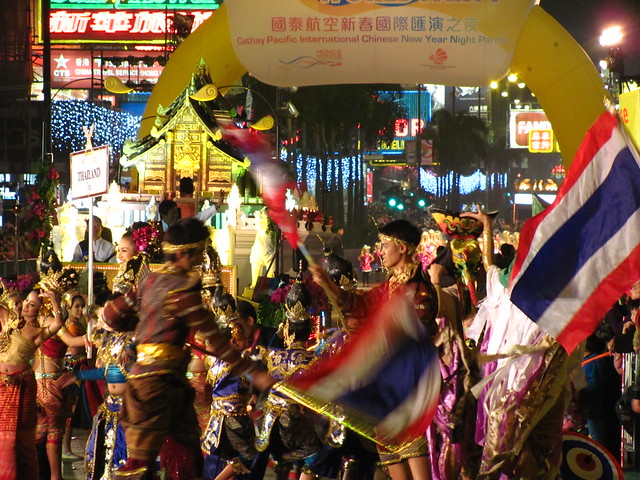
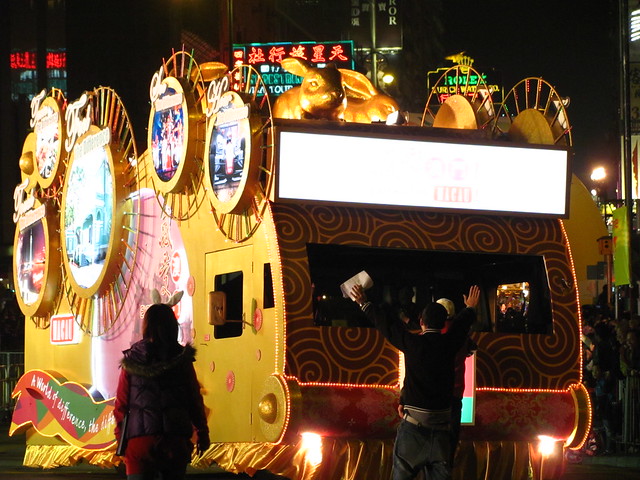
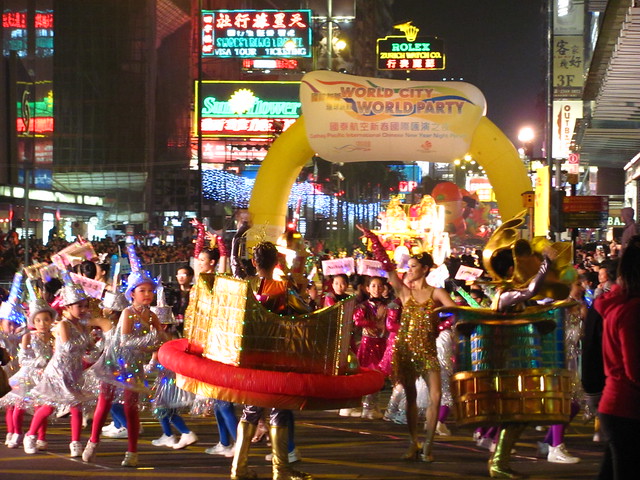

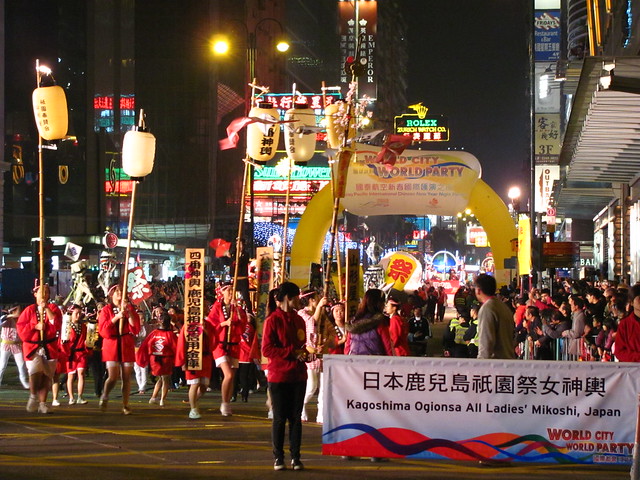
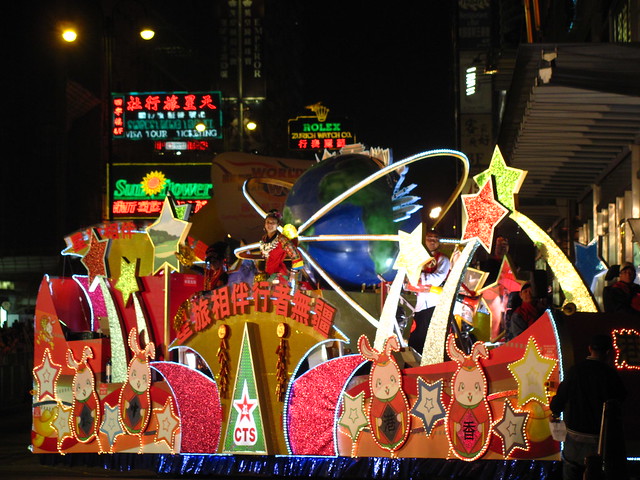 After it was over at 10:30pm we were famished and exhausted. By this point I had already spent a week trying to adapt my diet to Cantonese cooking, and by this point I really just craved a big American steak. Lo and behold, we found a sign in a nearby mall for the next best thing: a late night Australian steak at Outback!
After it was over at 10:30pm we were famished and exhausted. By this point I had already spent a week trying to adapt my diet to Cantonese cooking, and by this point I really just craved a big American steak. Lo and behold, we found a sign in a nearby mall for the next best thing: a late night Australian steak at Outback!
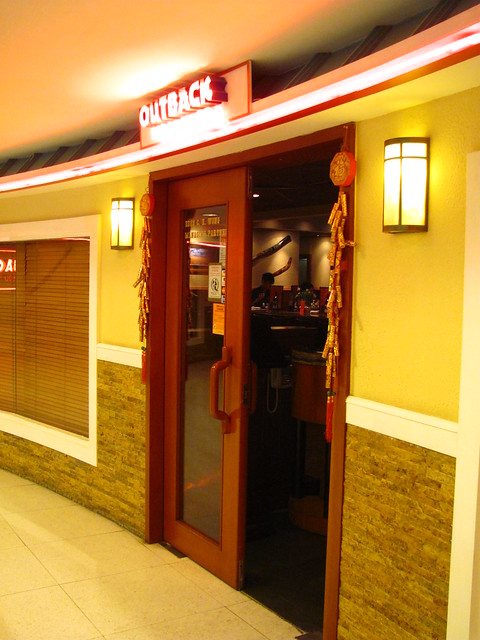 Finally, New Year’s Eve of 2011 was upon us, the Year of the Rabbit. For tonight, we ventured out to watch the fireworks over Victoria Harbour. Along the way we saw a few colorful Chinese lantern displays.
Finally, New Year’s Eve of 2011 was upon us, the Year of the Rabbit. For tonight, we ventured out to watch the fireworks over Victoria Harbour. Along the way we saw a few colorful Chinese lantern displays.
As you can imagine, crowds were extremely heavy. Possibly the most people in a single area I’ve ever been part of in my life. Eventually we hit a point where we could move no further, which was less than ideal as a building was blocking a chuck of the view.
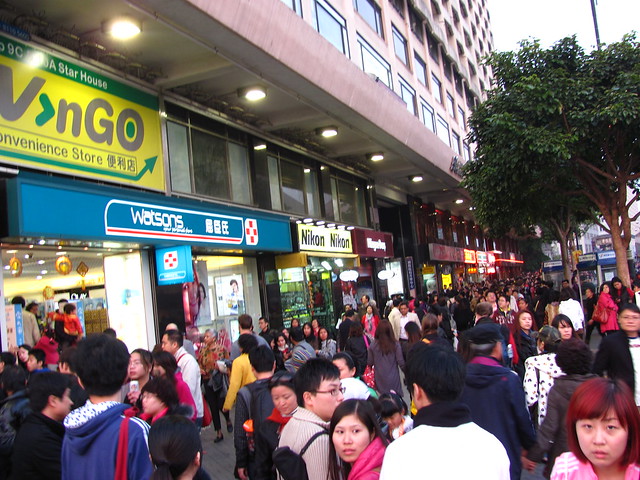
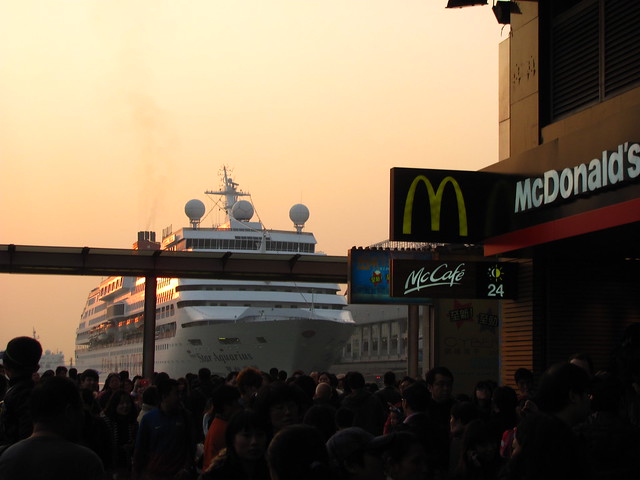
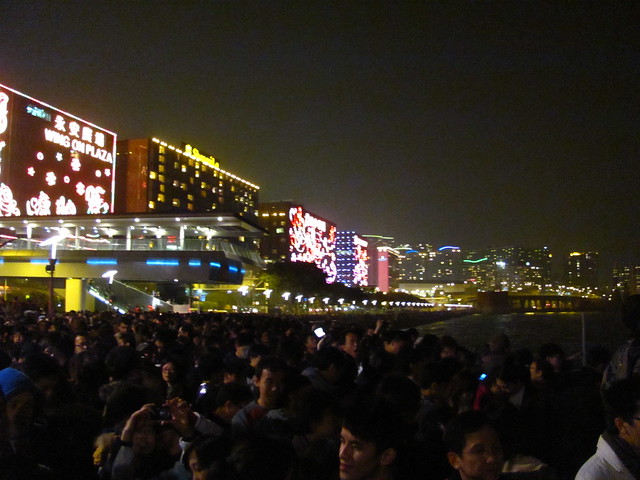
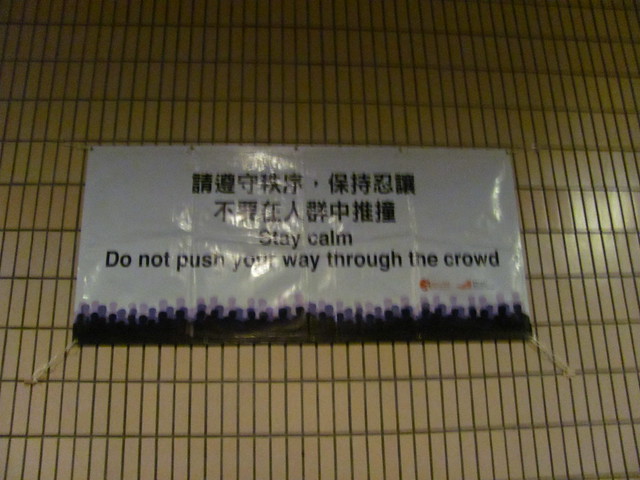 Despite the partially obstructed view, we were still treated to an impressive (and long!) firework display. By the end there was so much smoke in the air that the fireworks were barely visible anymore.
Despite the partially obstructed view, we were still treated to an impressive (and long!) firework display. By the end there was so much smoke in the air that the fireworks were barely visible anymore.
Kung Hei Fat Choi! Happy Year of the Rabbit! (From 2011!)
Because so much of my experience in Hong Kong happened during these first couple of weeks before classes began, the timeline across parts 1, 2, 3, and 4 of this photo journal might overlap for the sake of presenting a streamlined narrative. While I’m mostly putting this series together for the benefits of my own memories, hopefully it’s still of interest to a few readers out there.
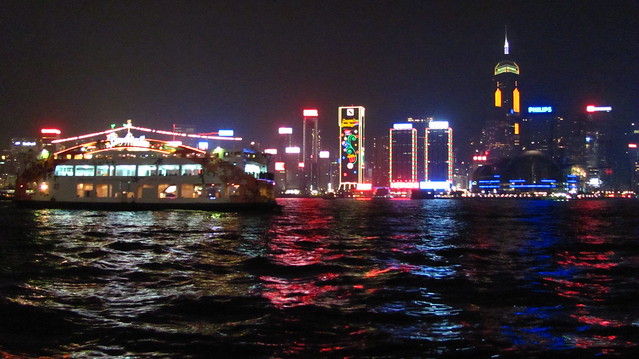
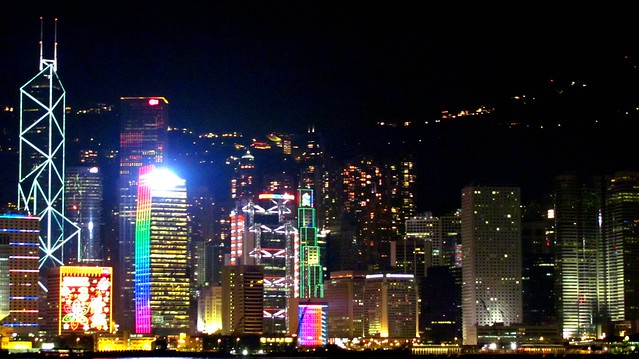
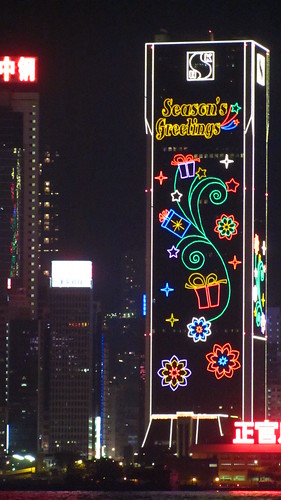
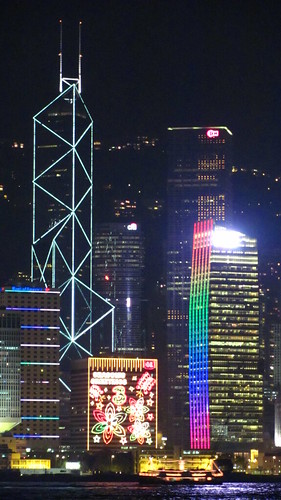
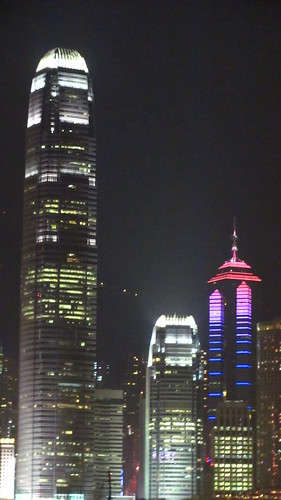
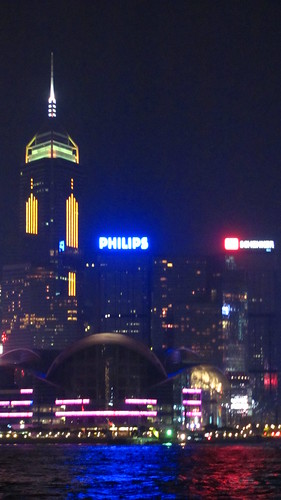
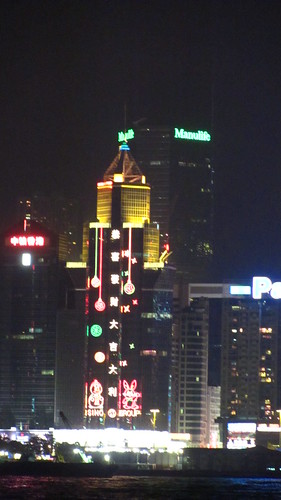
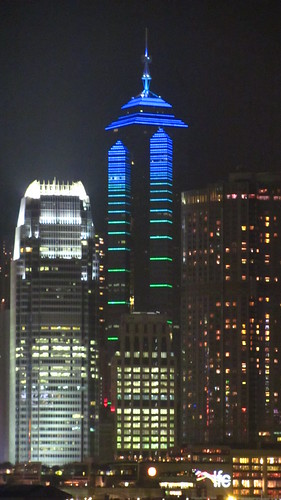

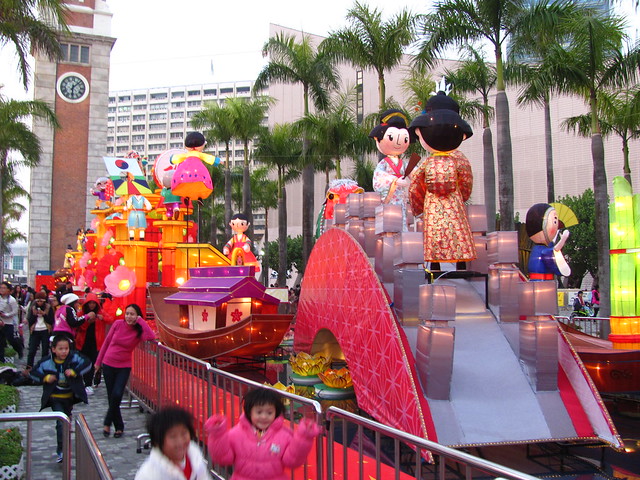
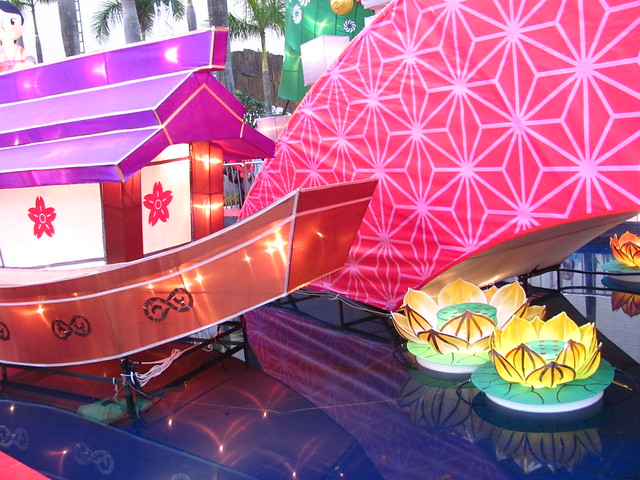
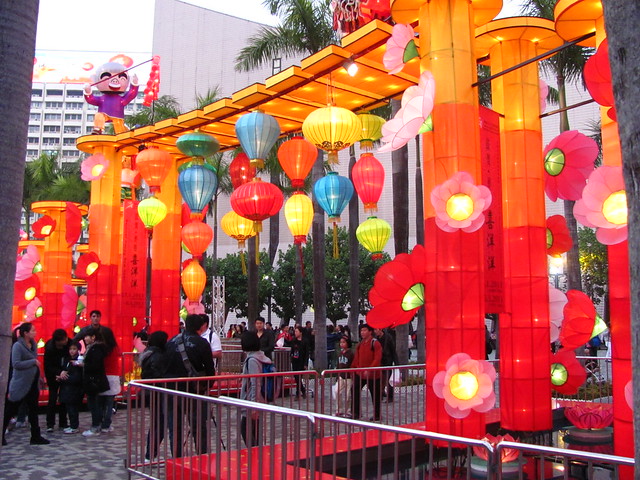
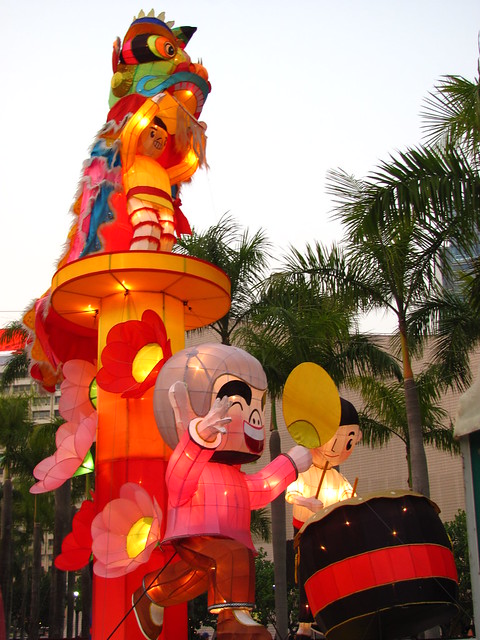
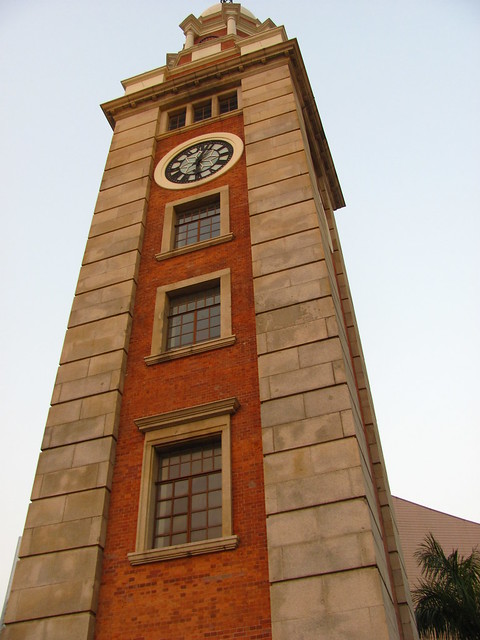
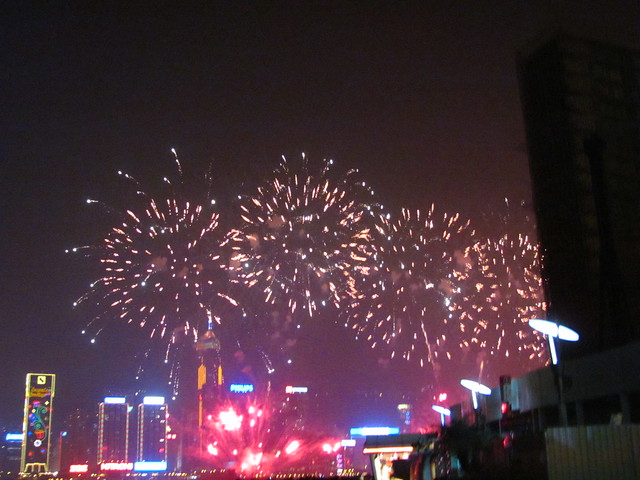
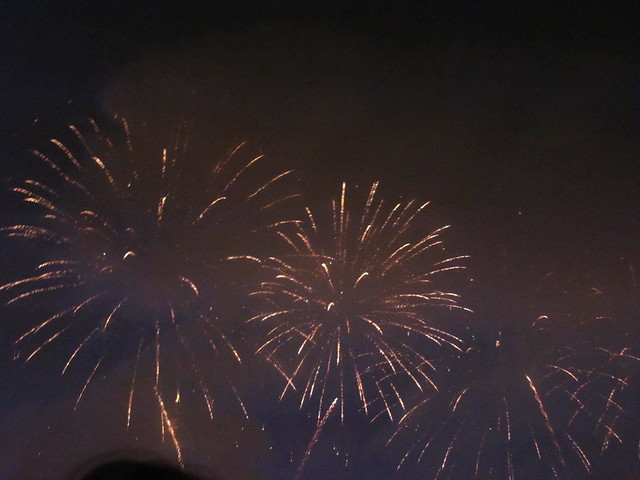
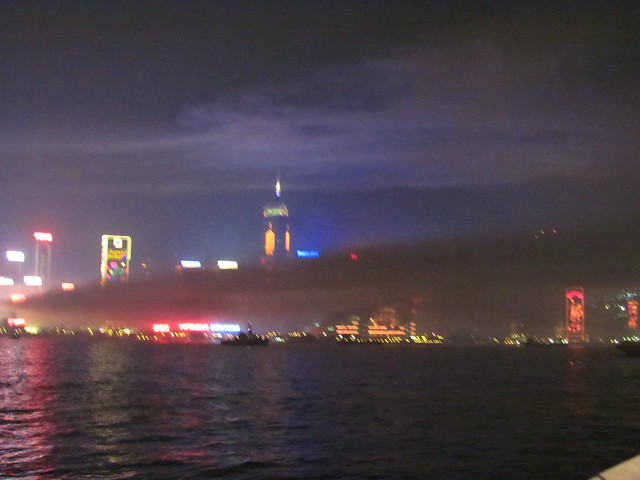
Amazing variety of rides and activities for all ages, making it a perfect family destination!